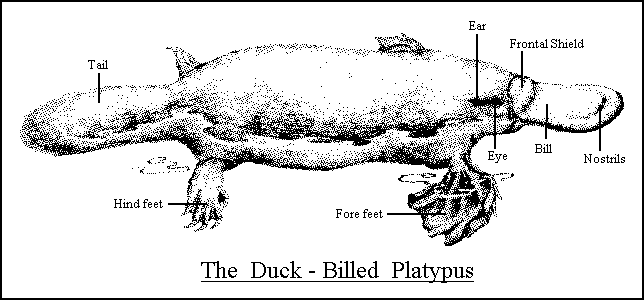
Photo courtesy of http://www.healthsci.utas.edu.au/physiol/mono/Platpage.html
|
|
| Home Page | 
Photo courtesy of http://www.healthsci.utas.edu.au/physiol/mono/Platpage.html |
| A member of the order Monotremata, the platypus is a type of animal that displays many reptilian characteristics despite being regarded as mammalian. The platypus has fur and mammary glands like a mammal, but also lays eggs and has one urogenital opening, used for both digestion and reproduction, much like a reptile. Also, like mammals, the platypus is able to regulate its body temperature, but their core body temperature is only 32 oC, which is low for a mammal, but high for a reptile. Lastly, a platypus is one of two mammals to produce venom, a trait that is strongly associated with reptiles (Torres et al., 1999; Tonkin and Negrine, 1994). |
Figure 2: Diagram displaying Morphology of Platypus

Photo courtesy of http://www.platypus.org.uk/det-descrip.html |
|
The male platypus has “a sturdy erectile keratin spur on each hind leg (Fig. 2) just above the webbed foot, which is connected via a venom duct to a venom (crural) gland lying under the dorsal thigh muscles.” The male platypus aggressively injects venom into his opposition by "erecting the spur, grasping and squeezing the victim between his hind legs, and driving the spurs and venom into the victim’s tissues" (Fenner et al., 1992). When the platypus contracts his leg muscle, he also contracts the muscle wall of the crural gland, which forces 2-4 mL of venom through the hollow spur and into the victim (Fenner et al., 1992). However, after considering the diet of the platypus, one realizes that platypuses, unlike reptiles, do not use venom as a way to disable and digest prey. Instead, it is believed that the platypus uses its venomous spur as an offensive mechanism against rival males during mating season. This hypothesis is strengthened by the fact that venom production by the male platypus is significantly increased between the months of July and October, the known breeding platypus breeding period (de Plater et al., 2001; Torres et al. 1999).
|
 |